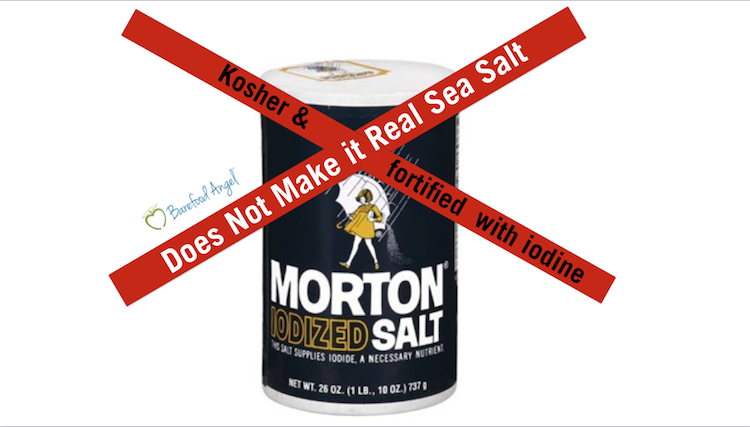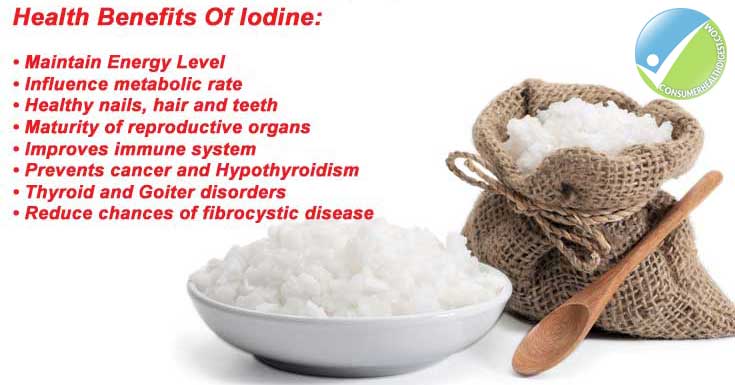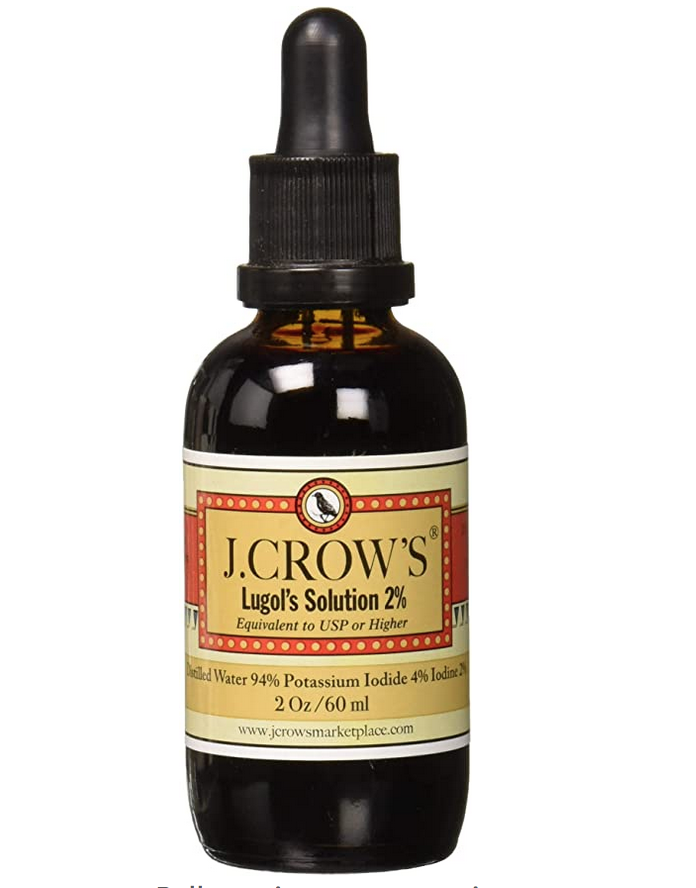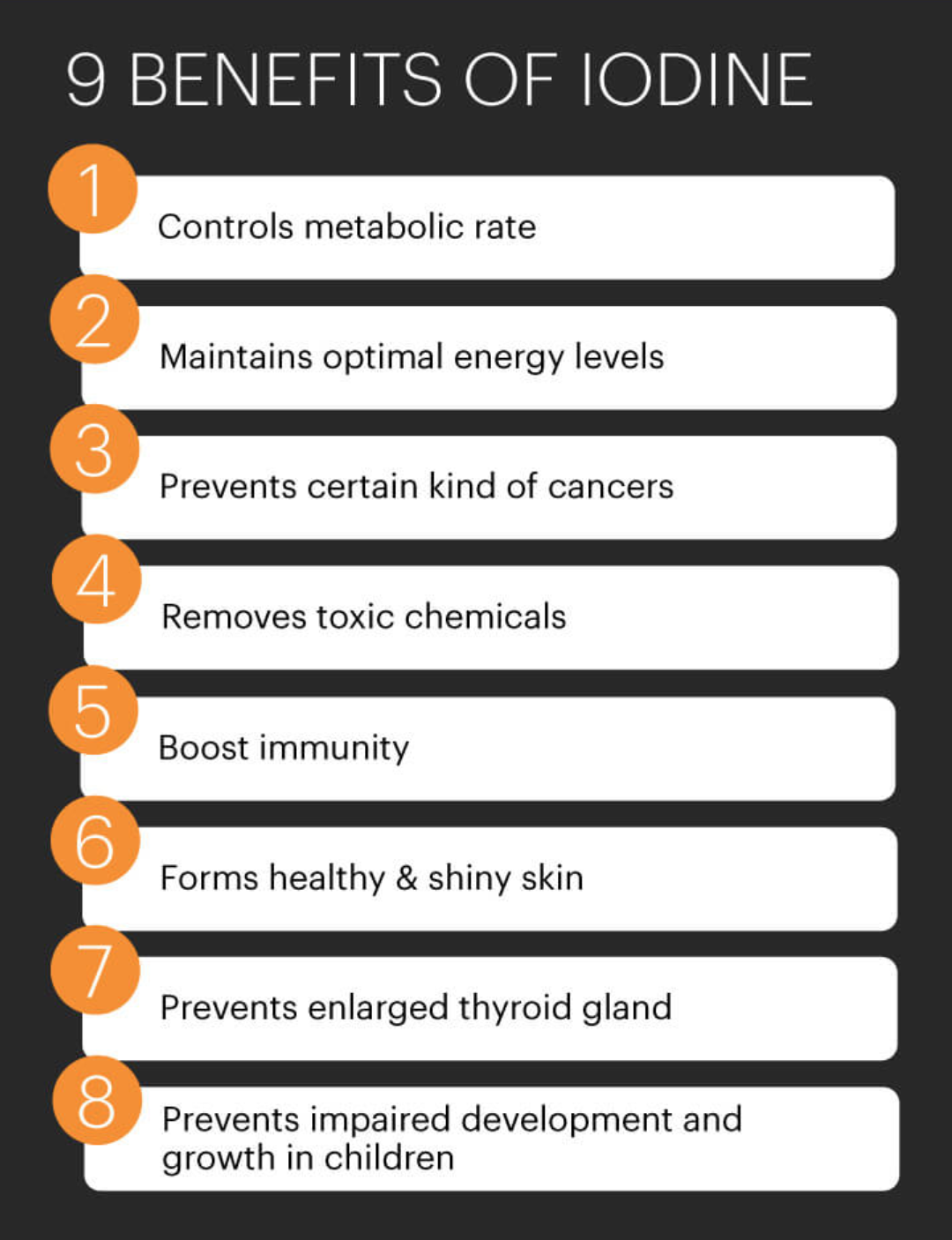What The Government And Corporate America Doesn’t Want You To know About Iodine And Salt
Some say cutting salt consumption can lower your death risk; others say the salt threat is overblown. What The Government And Corporate America Doesn’t Want You To know About Iodine And Salt
As Americans have become more aware over the years of nutrition-related health issues, salt has emerged as a major villain in many people’s minds. So much so that the Centers for Disease Control and Prevention describes reducing the U.S. population’s consumption of sodium as “a national priority.” The CDC warns that too much salt can raise people’s blood pressure, putting them at greater risk for heart disease and stroke, among other evils.

Arguing in favor of a broad reduction in Americans’ salt consumption is Elliott Antman, a cardiologist at Brigham and Women’s Hospital in Boston and president of the American Heart Association. Warning of the possible health consequences of an overzealous antisalt drive is David A. McCarron, an adjunct professor in the University of California-Davis Department of Nutrition and chairman-elect of the American Society for Nutrition’s Medical/Nutrition Council.

YES: Less Salt Reduces The Risk of Heart Disease
Everyone should be taking steps to limit salt in their diet, for one simple reason: to lower their risk of death.
Americans on the whole eat too much sodium. Most professional health authorities and scientific bodies agree on that point. And eating too much sodium can raise your blood pressure, putting you at greater risk of heart disease—the leading cause of death in the U.S.—and stroke, as well as worsening several other conditions.
Reducing salt intake is particularly important for people who already have high blood pressure, as well as those with diabetes or chronic kidney disease, middle-age or older people and African-Americans. All these groups tend to show a greater blood-pressure response than others to lower sodium intake.
Together, they represent about half the U.S. population age 2 and older.
But that doesn’t mean the other half of the population shouldn’t be concerned about the amount of salt they eat. The effect of too much sodium on blood pressure also is more pronounced in people who are overweight—who comprise nearly 70% of the U.S. adult population and about a third of American youths. And for everyone, lowering dietary sodium can significantly blunt the rise in blood pressure that tends to occur as we age. This is important because 90% of all Americans are expected to develop high blood pressure in their lifetime.
The Good News: Even incremental reductions in sodium consumption can make a big difference. Americans currently consume about 3,500 milligrams of salt a day on average. By one estimate, reducing that average by 400 milligrams a day could avert 15,000 to 32,000 deaths a year and $4 billion to $7 billion in annual health-care expenses. Only patients with very rare disorders, and only on the advice of their doctors, shouldn’t be reducing their sodium intake.
A Matter of Taste:
Some argue that our salt consumption is driven by what our bodies need. But research suggests that taste preferences are the real driving factor. And those preferences are driven by the high salt levels in the global food supply, particularly in packaged and restaurant foods.
Studies show that people who begin eating lower-sodium diets start preferring them, eventually finding that foods they used to enjoy taste too salty. The shift in preference can be moved in the other direction as well; when people are placed on a higher-salt diet, they come to like more salt in their foods.
If sodium is reduced gradually enough, taste differences are often negligible and undetected. This suggests that if the sodium in the U.S. food supply is gradually reduced, American consumers’ preferences for salt in foods would shift downward, and they would still enjoy their food. In the United Kingdom, a salt-reduction program started in 2003, centered on voluntary sodium guidelines, resulted in a 15% reduction over eight years in the population’s sodium intake, as well as reductions in blood pressure, heart attacks and strokes.
Making It Happen:
Another claim made by some is that lowering sodium in the diet can trigger hormonal reactions that increase the risk of heart disease.
First, many of the studies suggesting a link between lower sodium and heart disease have a number of methodological problems. Also, hormonal changes are known to be greater with large, abrupt changes in sodium intake, which may not be relevant to the gradual, sustained reductions advocated by most doctors and public-health officials. There is far greater certainty that high blood pressure is a factor in heart disease than there is about the possible role of these hormonal changes.
We know how to reduce the dangers of high blood pressure. We just need to do it.
NO: A Low-Salt Diet Is Neither Safe Nor Feasible
Current U.S. health policy calls for all Americans to restrict their dietary salt intake. This policy is neither feasible nor safe.
Why Not Feasible? Because public policy can’t overcome biology. Our appetite for sodium is driven by our body’s needs, not by the foods we eat. A specific range of sodium is needed to maintain adequate blood flow to the body’s critical organs, and our brains know when more or less salt is necessary.
Evidence of the brain’s tight control over our salt appetite comes from multiple government-sponsored surveys demonstrating a remarkably consistent range of sodium intake among people world-wide over many years—despite very different food supplies, with different sodium content, in different societies. In more than 50 surveys over the past five decades, conducted in more than 45 countries and monitoring about 200,000 people, sodium intake ranged from 2,800 to 5,000 milligrams a day and averaged 3,700 milligrams a day—or about what Americans consume on average today.
Why is a policy of restricting dietary sodium not safe? Because recent studies indicate that for many, it can be harmful. When salt consumption is too low, blood flow diminishes. The body’s rescue systems kick in, and the blood levels of the hormones that monitor blood flow to the organs increase, until optimal blood flow is re-established. If sodium intake is inadequate over time, the increased hormone levels impose a price—cardiovascular disease. Numerous reports in the medical literature have documented that people who consume less than 2,800 milligrams of sodium a day are at significantly greater risk of cardiovascular events and death than those who eat salt within the healthy range science has identified.
It’s Not For Everyone
There may be benefits for some individuals in reducing their salt consumption, but that must be determined individually in consultation with a health professional. For most Americans, it simply isn’t necessary and is potentially harmful.
Researchers from the University of Copenhagen and myself recently analyzed 167 published trials that measured the effect on blood pressure from reduced sodium. We found that in the studies involving only subjects with normal blood pressure, sodium restriction had no significant impact. That means there is no scientific justification for a U.S. sodium policy directed at the entire population, because 65% to 70% of Americans have normal blood pressure and thus wouldn’t benefit from lowering their salt intake.
For those whose blood pressure is sensitive to salt intake, research has shown that their sensitivity can be reduced by eating more fruits, vegetables and dairy products—a safer approach than reducing salt intake to potentially unhealthy levels.
The idea that an entire population can get used to a diet with less salt, overriding the brain’s need-based appetite, has never been proved.
The push by the British government in the past decade succeeded in lowering the sodium content of the food supply, but consumption remained well within the normal range established by the decades of studies I referred to earlier. In other words, the neural network that monitors the body’s need for sodium remained in charge.
Change With The Times
The U.S. sodium guidelines of the past 35 years are based in part on the idea that there is little risk, if any, in reducing salt consumption.
But research has identified the biological basis for very real and substantial risks and no blood-pressure benefit for most of us.
This is a predictable shift, as science isn’t static. Our improved understanding of sodium and health should be viewed as a triumph for the public’s support of scientific investigation. Now, health policy must evolve along with the science.
Bromide And Iodine Deficiency
There are two main reasons why iodine deficiency may be making a comeback.
Until recently, about 25 percent of the iodine in the diet was from wheat, because iodine was used in the processing of flour.
Now, however, a lot of flour in the U.S. is processed with a chemical cousin of iodine, bromide (potassium bromate), which helps makes flour doughier, rise higher, and gives the loaf a better appearance.
But bromide is a double-edged sword: not only has it replaced iodine, it may block the activity of iodine. That’s also true for two more of iodine’s chemical cousins — chlorine and fluoride, both of which are common in drinking water.
There’s another problem with bromide. The International Agency for Research on cancer classified potassium bromate as a Class 2B carcinogen, and it was banned in the U.K. in 1990 and in Canada in 1994.
It’s still legal in the U.S., although in 1999 The Center for Science in the Public Interest (CSPI) petitioned the FDA to ban it, saying the agency “has known for years that bromate causes cancer in laboratory animals.”
Iodine deficiency isn’t only about our daily bread — it’s also about our daily salt.
Most of the salt used in food processing isn’t iodized. And people are using less and less iodized table salt at home, because of the misguided medical advice (except in those with heart failure) to avoid salt.
The end result is Americans who dine on less iodine. From 1971 to 2001 iodine intakes in the U.S. dropped by 50 percent(estimated by urine output).
Though it fortunately is not continuing to drop, we still have lost half our iodine.
IODINE Deficiency; Allowing Flouride, Bromide, and Chloride to Wreak Havok on our systems.
Yes, we have iodine in table salt. Nowhere NEAR the amount our bodies require to combat the aggressive use of toxic halogens in our wonderful 1st world country.
I firmly believe that 99% of the “problems” humans create are just the result of a reduced capacity to think clearly. Caused by the many toxins that bombard our bodies and brains daily, along with the plethora of misinformation being spoon-fed from birth.
From the book “Iodine – Why You Need It, Why You Can’t Live Without It“
“Bromine was discovered in 1826. Bromide, (the reduced form of bromine), is rapidly absorbed in the intestinal tract. Bromine lies just above iodine in the periodic table. Because the size and weight of bromine is very close to iodine, these two items can compete with one another for binding in the body, especially in the thyroid gland. Bromine, being of similar size and shape to iodine, has the ability to bind to iodine receptors in the body. However, bromine should be considered a toxic element to the body and needs to be avoided. When bromine binds to iodine receptors in the thyroid gland, it disrupts normal thyroid functioning. Iodine is utilized by the thyroid to make thyroid hormone.
When bromine replaces iodine, the thyroid hormone produced by the thyroid gland can be brominated rather than iodinated. My experience has clearly shown that bromine toxicity leads to a plethora of thyroid problems, including autoimmune thyroid illnesses such as Graves’ disease and Hashimoto’s disease as well as hypothyroidism. Since iodine and bromine compete with one another for absorption and receptor binding, the body can only eliminate bromine if there is sufficient iodine available. Bromine intoxication (i.e., bromism) has been shown to cause delirium, psychomotor retardation, schizophrenia, and hallucination.
Subjects who ingest enough bromide feel dull and apathetic and have difficulty concentrating.
Bromide can also cause severe depression, headaches, and irritability. It is unclear how much bromide must be absorbed before symptoms of bromism become apparent. The symptoms of bromide toxicity can be present even with low levels of bromide in the diet.
Keep in mind, that when the body has insufficient iodine, the toxicity of bromine is accelerated.”
“There is no known therapeutic value for bromide. Therefore, any level of bromide could possibly cause problems. In one study, even before the patients took iodine, they were excreting too much bromide. After taking 50mg of iodine/iodide their bromide excretion increased nearly 50% from the baseline. Ingesting iodine caused the body to excrete larger amounts of bromide. This small study illustrates the detoxifying effects of iodine. Why are bromide levels so high in so many people? The next sections will answer this question in more detail.”
Bromine Added To Bakery Products:
Bromine is a toxic element and has no place for ingestion in man. Bromine is considered a goitrogen, which is a chemical that causes a goiter of the thyroid gland. Bromine interferes with iodide uptake and utilization in the thyroid gland.
There is no reason to use bromine in a medication and certainly no reason to use bromine in a common food source. In the early 1960’s, iodine was used in the manufacturing process of bakery products, including bread, as an anti-caking agent. One slice of bread contained up to 150μg of iodine, which was the RDA for iodine. In 1965, The National Institute of Health reported that the average iodine intake from bakery products was 726μg of iodine per day.
Some researchers felt that this amount of iodine could cause problems with the thyroid gland. Due to the erroneous concern of getting too much iodine from bakery products, iodine was replaced with bromine in the 1980’s.
This was a tremendous mistake. As can be seen from previous chapters, the amount of iodine in the bakery products was not even close to approaching a toxic level. The replacement of iodine by bromine not only increased the incidence of iodine deficiency, it also increased the levels of bromine in the population. This single act of replacing an essential element–iodine–with a goitrogen–bromine–might be responsible for the rapid decline in iodine levels we have experienced over the last 40 years.
Fluoride:
Fluoride, like bromide, is in the family of halogens. For over 50 years, the American Dental Association has advocated the addition of fluoride to drinking water as a preventative measure against dental cavities. However, there is much evidence to suggest that fluoride added to the water supply is ineffective at preventing caries. A study in New Zealand found that there was no difference in tooth decay rates between the fluoridated and the non-fluoridated areas.
This study has been repeated elsewhere. Many European countries have recognized the fallacy of adding fluoride to the water supply and have stopped the practice. The fluoridation of the water supply has been based on terrible science and is causing much more harm than good. Fluoridation has been linked to dental fluorosis (discoloration of the teeth), hip fractures, bone cancer, lowered intelligence, kidney toxicity, and other negative effects. There have been no studies which prove that long-term ingested fluoride has any positive effect. Fluoride is known to be a toxic agent. Fluoride has been shown to inhibit the ability of the thyroid gland to concentrate iodine.
Fluoride was first reported to cause thyroid problems in 1854 when fluoride was found to be a cause of goiter in dogs.
Research has shown that fluoride is much more toxic to the body when there is iodine deficiency present.
Many commonly prescribed medications contain fluoride including the popular SSRI antidepressants such as Paxil and Prozac. Interestingly, there have been reports of this class of antidepressants increasing the risk of breast cancer.
Many medications that contain fluoride have been pulled from the market due to serious adverse effects. These include the cholesterol-lowering drug Baycol, Propulsid (for stomach ulcers), Posicor (anti-arrhythmic), Astemizole (allergies), Omniflox (antibiotic), Fen-Phen (weight loss) and many others. Fluoride is still used in many medications. I believe that no medication should contain any toxic halogen, fluoride included. Interestingly, many fluoridated medications have been recalled due to an increased incidence of serious adverse effects.
Chloride:
Chloride, like iodide, fluoride, and bromide is from the family of halogens. Chloride is an important element in the extracellular fluid. There is a large amount of chloride found in the body—approximately 100gm. Chlorine (the oxidized form of chloride) is added to many products including the municipal water supply as well as to swimming pools and hot tubs as a disinfectant. It is also used as a whitener. However, chlorine is a toxic element. A byproduct of chlorine use is the production of dioxin. Dioxin is one of the most toxic carcinogens known to mankind. It does not readily break down in the environment. Chlorine and its byproducts have been linked to birth defects, cancer22, reproductive disorders including stillbirth,23 and immune system breakdown. Americans are exposed to a high level of chlorine and chlorine byproducts that are toxic to their health. This includes being exposed to the steam of the dishwasher when the door is opened after cleaning (chlorine superheated and combined with detergent). In addition, the widely used sugar-substitute Sucralose (Splenda®) contains chlorinated table sugar.
No one denies the importance of having clean drinking and swimming pool water that is free of bacteria. However, there are many safer alternatives to disinfecting water including the use of iodine, hydrogen peroxide, ultraviolet light, and ozone that could be substituted for chlorine.
We are in the midst of a cancer epidemic. At the present time, one in three Americans will get cancer. Cancer is not caused by chemotherapy, radiation, or surgery deficiency. Cancer is a multifactorial illness that will only be conquered when the underlying causes of cancer are properly thought out and thoroughly dealt with. There is no doubt that our exposure to toxic chemicals is increasing at the same time our nutrient status is declining. Is it any wonder that cancer rates are reaching epidemic proportions? Currently one in seven women (14%) has breast cancer and one in three men (33%) has prostate cancer. Iodine deficiency coupled with the increasing toxic load in our bodies could explain a great deal about why these cancer numbers are so high. Iodine supplementation has multiple positive effects on the body. These positive effects are found in many different illnesses from fatigue states to autoimmune disorders and cancer. It is important not only to ensure adequate levels of nutrients in the body, but also to help the body utilize these nutrients by enhancing the detoxification mechanisms. Iodine supplementation will not only provide a valuable nutrient for the body, it will also aid in the detoxification process of the body. The next chapter will give you information about detoxification. I believe ensuring an adequate iodine level is a crucial factor to helping you achieve your optimal health.”
The Iodine Deficiency Epidemic — How To Reverse It For Your Health
Did you know that iodine deficiency is now regarded by the World Health Organization (WHO) as the most prevalent and easily preventable case of impaired cognitive development in children in the world? There are at least 30 million suffering from this preventable condition.
Iodine is a trace mineral and an essential component of the thyroid hormones, triiodothyronine (T3) and thyroxine (T4). These hormones regulate the metabolic activities of most cells and play a vital role in the process of early growth and development of most organs, especially the brain. Inadequate intake of iodine-rich foods leads to insufficient production of these hormones, which adversely affect the muscle, heart, liver, kidney and the developing brain. (1)
Here Are Iodine Deficiency Statistics That May Surprise You:
-
- The National Health Nutritional Examination Survey reported that iodine levels have decreased by 50 percent in the last 30 years.
- More than 96 percent of over 5,000 patients tested were iodine-deficient in a clinical study conducted by thyroid expert Dr. David Brownstein. (2)
- According to the WHO, iodine deficiency affects 72 percent of the world’s population.
- In 2011, 70 percent of households globally had access to iodized salt (3)
The term iodine deficiency disorders has been coined to represent the different array of disorder that result from iodine deficiency in a population. (4) These disorders are all preventable if the appropriate dose of iodine is administered. Common disorders that result from iodine deficiency are hypothyroidism, increased cholesterol levels, endemic goiter, cretinism, decreased fertility rate, increased infant mortality, fibrocystic breast disease, atherosclerosis and breast cancer. (5)
Related Articles:
The Iodine Deficiency Epidemic — How To Reverse It For Your Health
Dollar Stores Feed More Americans Than Whole Foods (#GotBitcoin?)
Consumer’s Appetite For Organic, Antibiotic / Hormone-Free Food Outstrips Supply (#GotBitcoin?)
Food Companies Get Until 2022 To Label GMOs (#GotBitcoin?)
Food, The Gut’s Microbiome And The FDA’s Regulatory Framework
Food Regulators To Share Oversight of Cell-Based Meat (#GotBitcoin)
Your Questions And Comments Are Greatly Appreciated.
Monty H. & Carolyn A.
Go back






Leave a Reply
You must be logged in to post a comment.